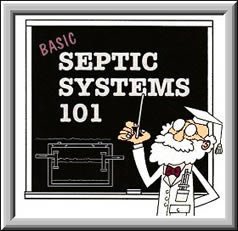 People who live in the countryside often have a septic system rather than having their homes hooked up to a central sewer system. A septic tank is just a big tank buried under the ground near the home where waste from the household plumbing is stored and processed. In this article, we will discuss the workings of septic tanks and provide advice for proper septic tank care.
People who live in the countryside often have a septic system rather than having their homes hooked up to a central sewer system. A septic tank is just a big tank buried under the ground near the home where waste from the household plumbing is stored and processed. In this article, we will discuss the workings of septic tanks and provide advice for proper septic tank care.
Old fashioned septic tanks are just large wooden tanks that hold and store plumbing waste and gradually allow the waste to leach into the soil as it processes. Modern septic tanks are often made of a heavy duty plastic material and include filters, pumps, alarms and other bells and whistles. About twenty-five percent of US households have a septic system.
Septic systems work through anaerobic bacterial processing. As the plumbing waste in the tank mineralizes and decomposes, anaerobic bacteria develop to assist with the breakdown of solid matter. You can also buy friendly bacterial and enzyme supplements to add to the tank (by simply flushing the product down the toilet) to further assist. This is recommended because it helps make the entire septic system process more efficient.
Some areas have codes in place that instruct homeowners to perform various maintenance tasks on their septic system; however, these are seldom enforced. While lack of maintenance does not usually cause immediate septic system problems, it will eventually result in breakdown and poor processing of waste. Good maintenance can keep a septic system operating efficiently for many decades.
Most septic tanks can hold as much as 1500 gallons of plumbing waste. The waste is piped into the septic tank from the house where it enters one of two chambers. In the first chamber, solid materials naturally sink to the bottom leaving liquids to move into the second chamber. The liquids move on through leach lines to a leach field while the solids stay in the first tank to be broken down by the anaerobic bacteria and enzymes. When the solid materials become liquid, they too move on to the leach field to be processed and absorbed by nature.
You should have your septic tank pumped out once a year to remove stubborn solid matter. This is especially true if you have a large family and your septic tank is used a great deal. In fact, if this is the case or if your septic tank doesn’t maintain a temperature that is adequate for efficient processing, you may need to have it pumped out more frequently.
It’s easy to see that it is very important to choose the right size septic tank for the amount of use it will handle. A 1000 gallon septic tank might be adequate for one or two people or for a vacation home. If you have quite a few people in your home and you live in it year-round, you should choose a 1500 gallon septic tank. If you are unsure, you should just go ahead and choose the larger tank. It is better to err on the side of excess, and your septic system will last longer and work more efficiently when you do.
By choosing the right septic system to begin with and maintaining it properly, you should have no problem with your septic system. Follow the tips presented here to enjoy country living trouble free with an efficient septic system.




